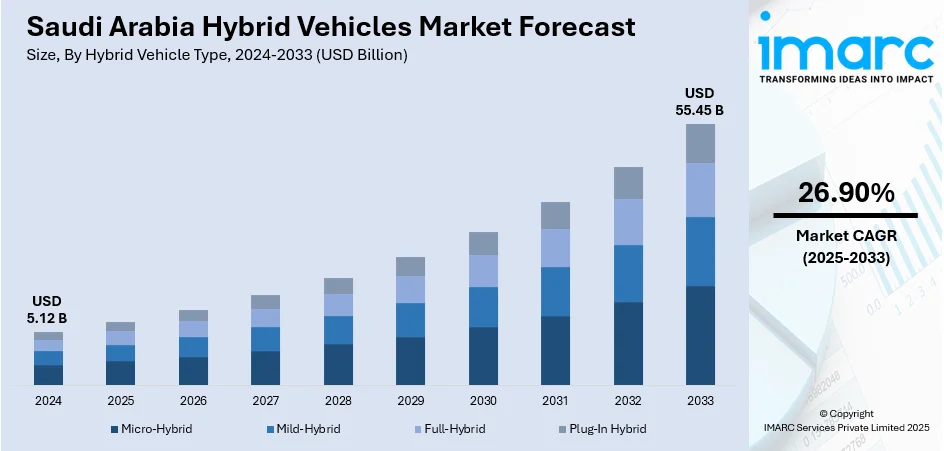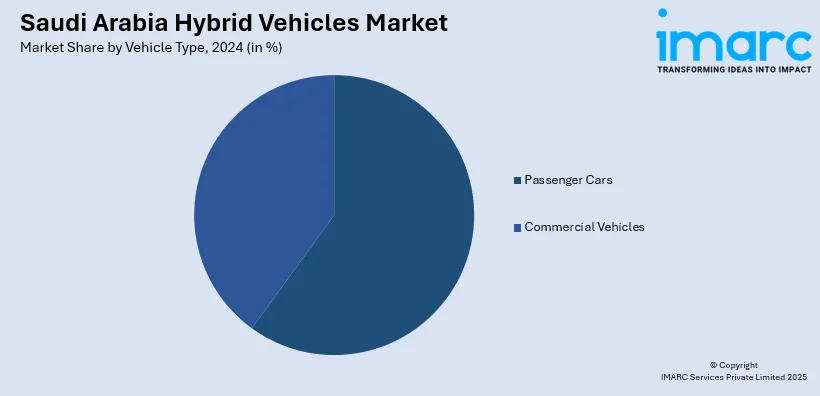
Saudi Arabia Hybrid Vehicles Market Size, Share, Trends and Forecast by Hybrid Vehicle Type, Vehicle Type, and Region, 2025-2033
Saudi Arabia Hybrid Vehicles Market Overview:
The Saudi Arabia hybrid vehicles market size reached USD 5.12 Billion in 2024. Looking forward, IMARC Group expects the market to reach USD 55.45 Billion by 2033, exhibiting a growth rate (CAGR) of 26.90% during 2025-2033. The market is driven by strong government incentives, including tax benefits and reduced registration fees under Vision 2030, accelerating hybrid vehicle adoption. Rising fuel prices and environmental awareness are shifting consumer preferences toward cost-efficient, low-emission hybrid models, supported by automakers’ localized offerings. Strategic investments in charging infrastructure are further augmenting the Saudi Arabia hybrid vehicles market share.
|
Report Attribute
|
Key Statistics
|
|---|---|
|
Base Year
|
2024 |
|
Forecast Years
|
2025-2033
|
|
Historical Years
|
2019-2024
|
| Market Size in 2024 | USD 5.12 Billion |
| Market Forecast in 2033 | USD 55.45 Billion |
| Market Growth Rate 2025-2033 | 26.90% |
Saudi Arabia Hybrid Vehicles Market Trends:
Increasing Government Support and Incentives for Hybrid Vehicles
The market is experiencing significant growth due to strong government support and incentives aimed at reducing carbon emissions. As part of Vision 2030, the Saudi government is promoting sustainable transportation by offering tax benefits, subsidies, and reduced registration fees for hybrid vehicles. In 2019, Saudi transport emissions were 136.38 MtCO₂e, as energy consumption increased from 686,806 TJ in 1990 to 1,907,802 TJ. The government is planning to achieve net-zero emissions by 2060 for electric cars and public transport, despite 99% of fuel consumption still coming from fossil fuels as the number of cars is projected to double by 2030 to 25 million, electric and hybrid mobility have an important role to play in the mitigation measures spelled out in Vision 2030. Additionally, the National Industrial Development Center (NIDC) is encouraging local manufacturing of hybrid and electric vehicles to decrease reliance on oil-based transportation. Public awareness campaigns and partnerships with global automakers are further accelerating adoption. With rising fuel prices and environmental concerns, consumers are increasingly opting for fuel-efficient hybrid models. The government’s push for green initiatives, including charging infrastructure development, is expected to sustain this trend, making hybrid vehicles a key segment in Saudi Arabia’s automotive future.

To get more information on this market, Request Sample
Rising Consumer Demand for Fuel-Efficient and Eco-Friendly Vehicles
Consumer preference in Saudi Arabia is shifting toward fuel-efficient and eco-friendly vehicles, propelling the Saudi Arabia hybrid vehicles market growth. High fuel costs and growing environmental awareness have led buyers to consider hybrid models that offer lower running costs and reduced emissions. In April 2025, Saudi Arabia's retail LPG price remained unchanged at a historic high of SAR 1.040 (approximately USD 0.28) per liter, identical to March and higher than the SAR 0.750 (approximately USD 0.20) per liter from the low in May 2022. The mean price since July 2020 is SAR 0.900 (approximately USD 0.24), calculated from 58 monthly observations. As hybrid vehicle adoption increases, stable prices for LPG enable more effective planning for alternative fuels in Saudi Arabia's changing transportation energy landscape. Automakers are responding by introducing affordable hybrid SUVs and sedans tailored to regional preferences, such as high-performance and luxury options. Additionally, younger, eco-conscious demographics are influencing purchasing trends, supported by flexible financing options from local dealers. As infrastructure improves, including more hybrid-friendly service centers, adoption rates are expected to rise further. This trend aligns with global sustainability goals, positioning Saudi Arabia as an emerging market for hybrid vehicle growth in the Middle East.
Saudi Arabia Hybrid Vehicles Market Segmentation:
IMARC Group provides an analysis of the key trends in each segment of the market, along with forecasts at the country and regional levels for 2025-2033. Our report has categorized the market based on hybrid vehicle type and vehicle type.
Hybrid Vehicle Type Insights:
- Micro-Hybrid
- Mild-Hybrid
- Full-Hybrid
- Plug-In Hybrid
The report has provided a detailed breakup and analysis of the market based on the hybrid vehicle type. This includes micro-hybrid, mild-hybrid, full-hybrid, and plug-in hybrid.
Vehicle Type Insights:

- Passenger Cars
- Commercial Vehicles
A detailed breakup and analysis of the market based on the vehicle type have also been provided in the report. This includes passenger cars and commercial vehicles.
Regional Insights:
- Northern and Central Region
- Western Region
- Eastern Region
- Southern Region
The report has also provided a comprehensive analysis of all the major regional markets, which include Northern and Central Region, Western Region, Eastern Region, and Southern Region.
Competitive Landscape:
The market research report has also provided a comprehensive analysis of the competitive landscape. Competitive analysis such as market structure, key player positioning, top winning strategies, competitive dashboard, and company evaluation quadrant has been covered in the report. Also, detailed profiles of all major companies have been provided.
Saudi Arabia Hybrid Vehicles Market News:
- May 28, 2025: Al-Futtaim BYD launched the SEAL 7 plug-in hybrid sedan in Saudi Arabia, priced at SAR 104,900 (approximately USD 27,955.85). This car has a range of over 800 km, produces 270 hp, and goes from 0 to 100 km/h in 7.9 seconds. With DM-i 4.0 technology and Advanced Driver Assistance Systems (ADAS), this model is aligned with Saudi Vision 2030 and the Kingdom's hybrid mobility goals. Customers will get an 8-year/200,000 km battery warranty and a 6-year/150,000 km vehicle warranty.
- November 05, 2024: Ford has launched the 2025 Taurus Hybrid in Saudi Arabia, powered by a 1.5L hybrid engine that delivers 185 hp and achieves a fuel economy of up to 15.3 km/l across all three trims. It comes with a 48 kW (64 hp) electric motor, 520L trunk space, and advanced safety tech, including six airbags and adaptive cruise control. Ford reinforces its commitment to electrified mobility in alignment with Saudi Arabia's clean energy ambitions with this launch.
Saudi Arabia Hybrid Vehicles Market Report Coverage:
| Report Features | Details |
|---|---|
| Base Year of the Analysis | 2024 |
| Historical Period | 2019-2024 |
| Forecast Period | 2025-2033 |
| Units | Billion USD |
| Scope of the Report |
Exploration of Historical Trends and Market Outlook, Industry Catalysts and Challenges, Segment-Wise Historical and Future Market Assessment:
|
| Hybrid Vehicle Types Covered | Micro-Hybrid, Mild-Hybrid, Full-Hybrid, Plug-In Hybrid |
| Vehicle Types Covered | Passenger Cars, Commercial Vehicles |
| Regions Covered | Northern and Central Region, Western Region, Eastern Region, Southern Region |
| Customization Scope | 10% Free Customization |
| Post-Sale Analyst Support | 10-12 Weeks |
| Delivery Format | PDF and Excel through Email (We can also provide the editable version of the report in PPT/Word format on special request) |
Key Questions Answered in This Report:
- How has the Saudi Arabia hybrid vehicles market performed so far and how will it perform in the coming years?
- What is the breakup of the Saudi Arabia hybrid vehicles market on the basis of hybrid vehicle type?
- What is the breakup of the Saudi Arabia hybrid vehicles market on the basis of vehicle type?
- What is the breakup of the Saudi Arabia hybrid vehicles market on the basis of region?
- What are the various stages in the value chain of the Saudi Arabia hybrid vehicles market?
- What are the key driving factors and challenges in the Saudi Arabia hybrid vehicles market?
- What is the structure of the Saudi Arabia hybrid vehicles market and who are the key players?
- What is the degree of competition in the Saudi Arabia hybrid vehicles market?
Key Benefits for Stakeholders:
- IMARC’s industry report offers a comprehensive quantitative analysis of various market segments, historical and current market trends, market forecasts, and dynamics of the Saudi Arabia hybrid vehicles market from 2019-2033.
- The research report provides the latest information on the market drivers, challenges, and opportunities in the Saudi Arabia hybrid vehicles market.
- Porter's five forces analysis assist stakeholders in assessing the impact of new entrants, competitive rivalry, supplier power, buyer power, and the threat of substitution. It helps stakeholders to analyze the level of competition within the Saudi Arabia hybrid vehicles industry and its attractiveness.
- Competitive landscape allows stakeholders to understand their competitive environment and provides an insight into the current positions of key players in the market.
Need more help?
- Speak to our experienced analysts for insights on the current market scenarios.
- Include additional segments and countries to customize the report as per your requirement.
- Gain an unparalleled competitive advantage in your domain by understanding how to utilize the report and positively impacting your operations and revenue.
- For further assistance, please connect with our analysts.
 Request Customization
Request Customization
 Speak to an Analyst
Speak to an Analyst
 Request Brochure
Request Brochure
 Inquire Before Buying
Inquire Before Buying




.webp)




.webp)












